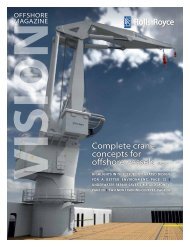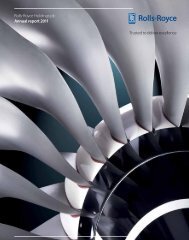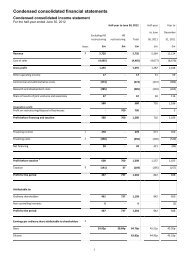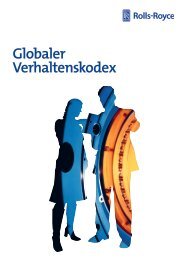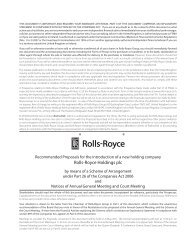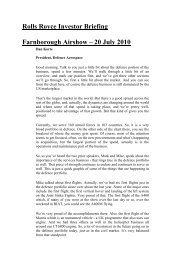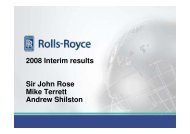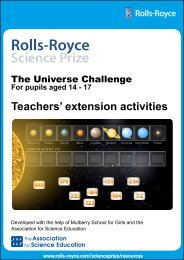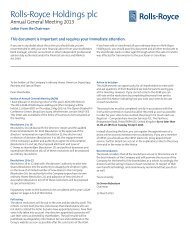Create successful ePaper yourself
Turn your PDF publications into a flip-book with our unique Google optimized e-Paper software.
The Universe Challenge<br />
For pupils aged 14 - 17<br />
Teachers’ <strong>game</strong> <strong>play</strong> <strong>notes</strong><br />
Developed with the help of Mulberry School for Girls and the<br />
Association for Science Education<br />
www.rolls-royce.com/scienceprize/resources
The Game<br />
The Universe Challenge<br />
The Universe Challenge is a <strong>game</strong> for two teams of pupils that includes interactive white board<br />
activities and desk based experiments. The following <strong>notes</strong> explain the <strong>game</strong> <strong>play</strong> and resources<br />
that you will need.<br />
Game Objective<br />
Teams win points by completing nine challenges<br />
The challenges are selected at random by teams as they progress through the <strong>game</strong><br />
Each challenge has an associated piece of<br />
printable artwork. When printed out these<br />
pieces of artwork map together to show a<br />
timeline of the history of the Universe since<br />
the Big Bang. Printer required.<br />
Game Play<br />
Starting the <strong>game</strong><br />
Split the class into two teams.<br />
Teams choose a team name and enter it on screen.<br />
The first team is then invited to select a challenge by choosing an on-screen challenge box.<br />
They then follow the instructions to win up to three points per challenge. For a desk challenge both<br />
teams participate and the teacher enters the points won by both teams on screen.<br />
www.rolls-royce.com/scienceprize/resources
The six on-screen challenges:<br />
The on-screen challenges are completed by three members of one team. They<br />
appear randomly so they cannot pick and choose which challenge to take.<br />
Atomic Structure<br />
Number of pupils involved: 3 (with the team supporting)<br />
Number of tasks: 3<br />
Number of points available: 3<br />
Time to complete each task: 90 seconds<br />
One member of the team comes to the front<br />
The team member has to drag the correct number of protons, neutrons and electrons from the banks<br />
on the right hand side into the centre for the atom they are given.<br />
They can change their mind and remove their choices as many times as they like within the time.<br />
Once they are happy that they have done the task correctly they click on the Finish button.<br />
One point is awarded for a correct answer. If the answer is incorrect they do not score a point for that<br />
task and the <strong>game</strong> continues to task 2.<br />
Protons and neutrons must be placed in the centre of the atom<br />
with electrons in the correct orbit to be awarded a point.<br />
This is then repeated by two more pupils.<br />
Correct answers (Three of the four possibilities will appear randomly):<br />
Hydrogen<br />
One Proton (in the nucleus) and one electron (in the first orbit). Adding a neutron to create<br />
deuterium is classed as an incorrect answer<br />
Helium<br />
Two protons and two neutrons (in the nucleus) and two electrons (in the first orbit)<br />
Carbon<br />
Six protons and six neutrons (in the nucleus) and six electrons (two in the first orbit and<br />
four in the second orbit)<br />
Oxygen<br />
Eight protons and eight neutrons (in the nucleus) and eight electrons (two in the first orbit<br />
and six in the second orbit)<br />
Discussion points<br />
Discussion of isotopes, ions, electron shells/orbits etc.<br />
www.rolls-royce.com/scienceprize/resources
On-screen challenge<br />
Energy in, Energy out<br />
Number of pupils involved: 3 (with the team supporting)<br />
Number of tasks: 3<br />
Number of points available: 3<br />
Time to complete each task: 60 seconds<br />
One member of the team comes to the front<br />
The team member then drags the type of energy to the spaces in the word equation. They can<br />
change their mind as many times as they like by dragging their answers out and replacing them.<br />
When they think they are correct they press Test.<br />
All correctly placed words will remain in their boxes, incorrect words will go back to the starting<br />
point for the team member to try gain.<br />
Once they are all correct the second part of the task is revealed and the team member must fill in<br />
the missing gap in the number equation. Once completed the Finish button must be pressed.<br />
This is then repeated by two more pupils.<br />
Correct answers (Three of the four possibilities will appear randomly):<br />
Car<br />
Chemical - Kinetic + Heat + Sound (In any order)<br />
100kJ - 20kJ + 74kJ + 6kJ<br />
Wind Turbine Farm<br />
Kinetic - Electrical + Heat + Sound (in any order)<br />
100MJ - 90MJ + 8MJ + 2MJ<br />
Television<br />
Electrical - Light + Sound + Heat (in any order)<br />
100kJ - 50kJ + 40kJ + 10kJ<br />
Human<br />
Chemical - Kinetic + Heat + Sound (in any order)<br />
100J - 1.4J + 98.5J + 0.1J<br />
Discussion points<br />
Efficiency, wasted energy.<br />
www.rolls-royce.com/scienceprize/resources
On-screen challenge<br />
Sound/Waves<br />
Number of pupils involved: 3 (with the team supporting)<br />
Number of tasks: 3<br />
Number of points available: 3<br />
Time to complete each task: 30 seconds<br />
One member of the team comes to the front<br />
The pupil must match the sound wave with the object or animal shown by first clicking on the sound<br />
then clicking the Finish button. It is worth reminding pupils about the range of human hearing<br />
(20Hz to 20kHz) and what a Hertz is.<br />
This is repeated by two more pupils.<br />
Correct answers (Three of the four possibilities will appear randomly):<br />
Cat: 2kHz<br />
Lion: 250Hz<br />
Grandfather clock: 1Hz<br />
Computer chip: 3GHz<br />
www.rolls-royce.com/scienceprize/resources
On-screen challenge<br />
Solar System<br />
Number of pupils involved: 3 (with the team supporting)<br />
Number of tasks: 3<br />
Number of points available: 3<br />
Time to complete each tast: 60 seconds<br />
One member of the team comes to the front<br />
The pupil must then drag the planets into the right order from the Sun. Once happy the pupil<br />
presses Test. Any planets in the w rong order will move back to their start positions and the<br />
pupil can try again. Once all the planets are in the correct position the Finish button must be<br />
pressed.<br />
Task 1 correct answers:<br />
Mercury Venus Earth Mars Jupiter Saturn Uranus Neptune Pluto<br />
The second pupil must then place the average surface temperature under the correct planets.<br />
Once happy the pupil presses Test. Any temperatures in the wrong place move back to their<br />
start positions and the pupil can try again. Once all the temperatures are in the correct position the<br />
Finish button must be pressed.<br />
Task 2 correct answers:<br />
Mercury Venus Earth Mars Jupiter Saturn Uranus Neptune Pluto<br />
179 449 7.2 -123 -153 -184 -185 -223 -234<br />
The third pupil is then asked to drag the number of Earth days that each planet takes to orbit the<br />
Sun under the correct planet. Once happy the pupil presses Test. Any times in the wrong place<br />
move back to their start positions and the pupil can try again. Once all the times are in the correct<br />
position the Finish button must be pressed.<br />
Task 3 correct answers:<br />
Mercury Venus Earth Mars Jupiter Saturn Uranus Neptune Pluto<br />
88 224 365 687 4,334 10,759 30,683 60,190 90,465<br />
Discussion points<br />
Pluto is included, but could be used to start a discussion on what makes an object a planet.<br />
www.rolls-royce.com/scienceprize/resources
On-screen challenge<br />
Gravity and Weight<br />
Number of pupils involved: 3 (with the team supporting)<br />
Number of tasks: 3<br />
Number of points available: 3<br />
Time to complete each task: 90 seconds<br />
One member of the team comes to the front<br />
The team member must drag the weights to the correct planets. Once happy the pupils presses<br />
Test. Any weights in the wrong order move back to their start positions and the pupil can try<br />
again. Once all the weights are in the correct position the Finish button must be pressed.<br />
Task 1 correct answers:<br />
Mercury Venus Mars Jupiter Saturn Uranus Neptune Pluto<br />
361 883 375 2600 1120 1050 1330 61<br />
The second pupil then puts the time a 2m pendulum takes to complete one oscillation under the<br />
correct planets. Once happy the pupil presses Test. Any times in the wrong order move back to<br />
their start positions and the pupil can try again. Once all the times are in the correct position the<br />
Finish button must be pressed.<br />
Task 2 correct answers:<br />
Mercury Venus Earth Mars Jupiter Saturn Uranus Neptune Pluto<br />
4.67 2.99 2.84 4.59 1.7 2.65 2.74 2.44 11.37<br />
The third pupil is asked to put the time taken for a ball to fall 20m on each planet in order. Once<br />
happy the pupil presses Test. Any times in the wrong order move back to their start positions<br />
and the pupil can try again. Once all the times are in the correct position the Finish button<br />
must be pressed.<br />
Task 3 correct answers:<br />
Mercury Venus Earth Mars Jupiter Saturn Uranus Neptune Pluto<br />
3.33 2.13 2.02 3.27 1.24 1.89 1.95 1.73 8.1<br />
Notes<br />
The values have all been calculated using the following values of “surface” gravity for the planets<br />
in m/s2<br />
Mercury Venus Earth Mars Jupiter Saturn Uranus Neptune Pluto<br />
3.61 8.83 9.8 3.75 26 11.2 10.5 13.3 0.61<br />
Discussion points<br />
Discussions about gravity, weight and mass. Look at how scientists calculate surface gravity and<br />
how this doesn’t necessarily follow the size of the planets.<br />
www.rolls-royce.com/scienceprize/resources
On-screen challenge<br />
Gas Tests<br />
Number of pupils involved: 3 (with the team supporting)<br />
Number of tasks: 3<br />
Number of points available: 3<br />
Time to complete each task: 60 seconds<br />
One member of the team comes to the front<br />
The pupil drags gas tests over the mystery gas canister until they know the name of the gas and<br />
then drag the name of the gas over the canister.<br />
This is repeated with the other canisters. Note: Pupils can only use a total of six gas tests<br />
to name all three gases.<br />
Correct answers: (each gas will only appear once)<br />
Oxygen relights glowing splint, does not change lit splint, limewater remains clear<br />
Hydrogen does not effect glowing splint, pops with lit splint, limewater remains clear<br />
Carbon Dioxide puts out glowing splint, puts out lit splint, limewater turns milky<br />
www.rolls-royce.com/scienceprize/resources
Desk challenges:<br />
When a team selects a desk challenge, both teams take part. Once completed<br />
the teacher adds the points scored for both teams using the on-screen scoring<br />
system.<br />
Mirror Maze<br />
Number of pupils involved: Whole class<br />
Number of tasks: 1<br />
Number of points available: Teachers’ choice, up to 5 per team<br />
Time to complete each task: To be decided by the teacher<br />
Equipment needed:<br />
Extras:<br />
Create a mirror maze (example attached)<br />
Ray/light boxes or other light source<br />
Plane mirrors<br />
Pencil<br />
Protractors<br />
Using a light box or torch and mirrors, pupils steer light through the maze without crossing any walls.<br />
Pupils can be involved holding mirrors, drawing the path of the light etc. Award points for how far the<br />
team manages to steer the light.<br />
Extension activities<br />
Pupils can draw the position of the mirrors and the route of the light and measure angles of incidence<br />
and reflection.<br />
.............................................................................................................................................................<br />
Floating and sinking<br />
Number of pupils involved: Whole class<br />
Number of tasks: 1<br />
Number of points available: Depends on number of objects used<br />
Time to complete challenge: To be decided by the teacher<br />
Equipment needed:<br />
Bowl or large beaker of water<br />
Items to place in water-fruit, cork, plasticine etc<br />
Teams decide if items will float or sink. Points awarded for correct answers.<br />
Discussion points<br />
Discussion of density.<br />
www.rolls-royce.com/scienceprize/resources
IN<br />
OUT
Final Challenge:<br />
The Big Bang<br />
The Big Bang Wordsearch<br />
Number of pupils involved: Whole class<br />
Number of tasks: 1<br />
Number of points available: 17<br />
Not timed<br />
For the final challenge both teams compete to find words in the on-screen wordsearch.<br />
When a team member from either team finds a word they come to the board, click on their team’s<br />
name then press the first and last letter in the word. If correct the word is crossed out and the team<br />
is awarded a point. The team cannot send another team member up to the board until the first<br />
person has sat back down.<br />
www.rolls-royce.com/scienceprize/resources
These <strong>notes</strong> have been compiled for <strong>Rolls</strong>-<strong>Royce</strong> plc with the<br />
help of Mulberry School for Girls, London and the Association<br />
for Science Education.<br />
Special thanks to Deborah Colvin and Nick Swift.<br />
Further information about Mulberry School for Girls’ prize<br />
winning entry is available on-line at:<br />
www.rolls-royce.com/scienceprize<br />
..................................................................................................<br />
The interactive <strong>game</strong>s and accompanying teachers’ <strong>notes</strong><br />
hosted on the <strong>Rolls</strong>-<strong>Royce</strong> Science Prize website are to be<br />
used for the benefit of schools and colleges only and a third<br />
party must obtain the written approval of <strong>Rolls</strong>-<strong>Royce</strong> plc if<br />
they intend to use any of the resources.<br />
Helpline for teachers:<br />
0800 028 07659<br />
www.rolls-royce.com/scienceprize<br />
..................................................................................................<br />
About <strong>Rolls</strong>-<strong>Royce</strong><br />
<strong>Rolls</strong>-<strong>Royce</strong> is a world-leading provider of power systems and<br />
services for use on land, at sea and in the air. We operate in<br />
four global markets – civil aerospace, defence aerospace,<br />
marine and energy. We employ 38,000 people in our business<br />
worldwide and operate in 50 countries.<br />
<strong>Rolls</strong>-<strong>Royce</strong> in Education<br />
<strong>Rolls</strong>-<strong>Royce</strong> is investing in education in order to:<br />
– Raise standards<br />
– Promote engineering, science and technology<br />
– Develop our employees<br />
– Influence policy and strategy in education<br />
– Support future resourcing needs<br />
For more information and access to our resources<br />
for schools, visit: www.rolls-royce.com/education<br />
R<br />
R<br />
© <strong>Rolls</strong>-<strong>Royce</strong> plc 2007<br />
<strong>Rolls</strong>-<strong>Royce</strong> plc<br />
65 Buckingham Gate<br />
London SW1E 6AT<br />
England<br />
www.rolls-royce.com




